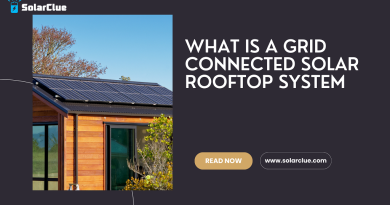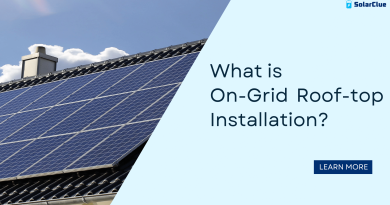Exploring the Setup of On-grid solar power system
Have you ever wondered how solar energy can power your entire house or business? Well, that’s where a setup-on-grid solar power system comes into play. In recent years, solar power has gained immense popularity around the world, and for good reason. Not only is it a clean and renewable source of energy, but it can also help you save money in the long run. In this blog, we will take a closer look at what a setup-on-grid solar power system entails and why it might be the perfect choice for you.
Table of Contents
What is a Setup-On-Grid Solar Power System?
A setup-on-grid solar power system, also known as a grid-tied solar power system, is a type of solar energy system that is connected to the electrical grid. Unlike off-grid systems that rely solely on solar panels and batteries, an grid system allows you to generate electricity using solar panels and feed any excess power back into the grid. Essentially, it works in conjunction with your electricity provider, providing you with the flexibility to both consume and produce electricity.
How Does It Work?
When you install a setup-on-grid solar power system, it consists of three main components: solar panels, an inverter, and a connection to the electrical grid. Solar panels, made up of photovoltaic cells, absorb sunlight and convert it into direct current (DC) electricity. The inverter then converts this DC electricity into alternating current (AC), which can be used to power your home or business.
The electricity generated by the solar panels can be used on-site to meet your immediate energy needs. However, on days when your energy consumption is lower than the amount of electricity produced by your solar panels, the excess power is fed back into the electrical grid. You are then credited for this surplus energy through a process known as net metering.
Advantages of Setup-On-Grid Solar Power Systems
1. Cost Savings: By generating your own electricity, you can significantly reduce or even eliminate your electricity bill. Furthermore, during times when you are producing more electricity than you need, you can earn credits or receive compensation from your electricity provider.
2. Environmental Benefits: Solar power is a clean and renewable source of energy that reduces your dependence on fossil fuels. By investing in a setup-on-grid solar power system, you can contribute to the fight against climate change and reduce your carbon footprint.
3. Energy Independence: With an on-grid system, you have the advantage of being connected to the electrical grid. This means that during periods when your solar panels are not generating enough electricity, you can still rely on the grid for power. On the other hand, if the grid experiences an outage, you can continue to generate your own electricity and enjoy uninterrupted power supply.
4. Easy Maintenance: Setting up a setup-on-grid solar power system is relatively straightforward, and once installed, it requires minimal maintenance. The lifespan of solar panels is typically around 25-30 years, and regular cleaning and occasional inspections are usually all that is needed to keep your system running optimally.
Conclusion
Harness the full potential of solar energy with SolarClue® and embark on a transformative journey towards a sustainable future. Investing in a setup-on-grid solar power system not only translates to substantial savings on your electricity bills but also plays a pivotal role in fostering a greener and more eco-conscious world. By tapping into the inexhaustible power of the sun, you actively reduce your reliance on finite, non-renewable resources and contribute significantly to the reduction of carbon emissions.
The added advantage of connecting to the electrical grid ensures a reliable backup system, enhancing the overall dependability of your energy supply. Whether for your home or business, if you are contemplating renewable energy options, a setup-on-grid solar power system is undoubtedly a venture worth exploring. Embrace the boundless power of the sun, and with SolarClue® by your side, make a positive impact on both your financial bottom line and the well-being of the environment. Seize this opportunity to pioneer change, and let SolarClue® illuminate the path to a brighter, more sustainable future for you and the generations to come and should enjoy.
Frequently Asked Questions
An on-grid solar power system is a setup where solar panels are connected to the public utility grid, allowing for both solar and grid power usage.
Unlike off-grid systems, on-grid solar systems remain connected to the main power grid, ensuring a continuous power supply.
Key components include solar panels, inverters, mounting structures, and a grid-tie connection to link the system with the utility grid.
Generally, on-grid systems don’t require batteries since they rely on the grid for power when solar production is low.
By feeding excess energy back into the grid, users can earn credits, ultimately reducing or eliminating electricity bills.
Regulations vary, but many regions require permits and approvals to ensure safety and compliance with local standards.
No, on-grid systems typically shut down during outages to prevent sending power into the grid and endangering utility workers.
On-grid systems are highly scalable, allowing users to customize the setup based on their energy consumption and goals.
Maintenance is minimal; regular cleaning and occasional checks on components like inverters ensure optimal system performance.
Many regions offer incentives, tax credits, or rebates to encourage the adoption of on-grid solar systems, making them more cost-effective for users.



Very informative blog… Thank you for sharing this information. Enertech specializes in solving the energy-related challenges of its customers by offering cost-effective and reliable solar inverter & power solutions.
Thank you for your feedback! I’m glad you found the blog informative. Renewable energy solutions are indeed crucial for a sustainable future!